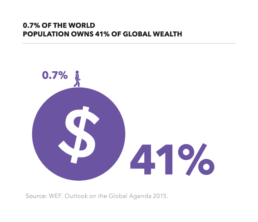Help us discover new solutions that help reach SDG 10 – reduce inequality within and among countries
As part of Sustainia’s ongoing quest to identify and map new market opportunities for a better tomorrow, we’re calling on you to help us discover new solutions that are addressing the global goals with the greatest untapped potential. Here, we dive into Sustainable Development Goal 10: reduce inequality within and among countries.
Whilst extreme poverty is declining, inequality is on the rise around the world. 41 percent of global wealth is controlled by just the richest 0.7 percent, whereas half the world’s population owns just 1 percent. Sustainable Development Goal (SDG) 10 aims to empower those at the bottom of the wealth ladder, regardless of sex, race or ethnicity.
Economic and social inequality are intrinsically linked. Health, crime, productivity, and life expectancy are all related to inequality, and more equal societies are shown to be happier societies. SDG 10 has also been identified by the UN’s Department of Economic & Social Affairs as critically connected to other SDGs, meaning that reducing inequality can act as a catalyst for advancing the other goals, especially SDG 1 (No poverty) and SDG 8 (Decent work and economic growth).

Progress on tackling inequality has been disappointingly slow, and current trends suggest that in every region of the world, inequality is set to flatline or worsen between now and 2030. A 2015 survey of business leaders showed that SDG 10 ranks lowly on the corporate conscience, meaning that when firms cherry-pick the goals they want to address, improving equality is often forgotten. DNV GL’s recent report – the Future of Spaceship Earth – indicated that SDG 10 is the goal least likely to be achieved by 2030. When the UN’s Economic and Social Council reported on the progress towards the SDGs earlier this year, they perhaps optimistically, stated that progress was ‘mixed’ on reducing inequality.
What are the opportunities?
In our 2017 Global Opportunity Report, we highlighted three new markets that address rising inequality, but given the urgency of addressing this goal, we want to provide more inspiration for action here. Business has the opportunity to create products and services that generate sustainable and inclusive growth, to build a more equal world. Blockchain is a great example of a sector that can unlock opportunities for the world’s poor and persecuted. The blockchain market is expected to grow at a compound annual growth rate of 61.5 percent, offering over $2 billion of new opportunities to be seized between 2016 and 2021.
This is where we need you!
Do you know about a solution that is helping to reduce inequality? It could be a blockchain platform that registers land rights, a mobile banking service for the unbanked, or something else that we couldn’t have dreamt of. We need your help to identify solutions that are readily available, financially viable, scaleable, have the capacity to improve quality of life, and have a positive environmental impact. We aim to showcase the best submitted solutions online and feature them in an upcoming report to show business around the world that there are commercial opportunities in all SDGs – also in the ones currently lagging behind. What solution has just popped into you mind?

Learn more about Sustainia’s crowdsourcing campaign, which seeks to identify innovation addressing the four SDGs (SDG 10, 12, 13 and 14) we are least on track to reach by 2030.
You can also check out all the solutions addressing inequality we already feature on Global Opportunity Explorer.
Author: Nic Craig

